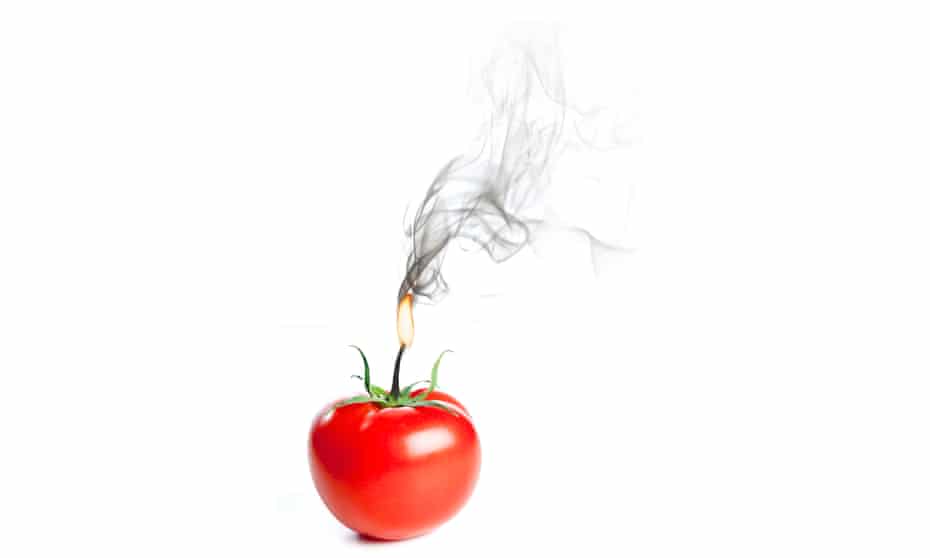reposted from the guardian
Scents and sensibility: what’s behind the rise of extreme smells?

From tomato-scented candles to perfumes reeking of intimate body parts, the world of smell is getting weirder. But are we ready to take our olfactory desires to the next level?
One night last week, I sat in my kitchen with my eyes closed, inhaling the rich, earthy scent of tomatoes. I felt transported: I was in an Italian garden, sun-dappled leaves swaying as I picked the plump, ripe fruit for a late pasta dinner with my large and beautiful family. I was, in essence, one of the puppets from the Dolmio adverts. But the smell wasn’t coming from a tomato. It was coming from a candle.
How did they make it smell so real? I called my boyfriend over to share in this miracle. He put his face right over the flame, said that it smelled like burnt nose hair and quickly lost interest. But I remained tickled by this magic trick. A candle, that smells like tomatoes!
There is something in the air at the moment, and it’s not just vine tomato candles: ever more eclectic smells – from the uplifting to the downright bizarre – have been making their way into perfume and candles. Is it a consequence of having been so smell-starved, so downright bored during the pandemic? An increased desire for the things we buy to give us experiences beyond mere enjoyment? And why do people want to smell weird stuff?
Our interest in these smells has now spread outside our homes and into our cultural, public spaces. The past year alone has seen: an exhibition of floating machines perfumed with smells of coal, marine life and vegetation at Tate Modern; a gallery in the Hague infused with the fishy odour of a 17th-century Dutch canal; and a dedicated olfactory art space launched in New York.
Olfactory art is far from new. Coffee beans were roasted behind a screen to create “the smell of Brazil” at the International Surrealist Exhibition of 1938. And let’s not forget the experiential dining experience at places like El Bulli and the Fat Duck at the start of this century. But the fact that we still view it as something of a novelty suggests we still view smell as a lesser sense.
Novelty scents have been around for a while. In the US, Demeter Fragrance Library was established in 1996 selling perfumes based on everyday scents. It started with Dirt, Grass and Tomato, and has since expanded into more unusual smells like Play-Doh, New Car and Funeral Home. Yankee Candles’ off-the-wall options have included Bacon, Schnitzel with Noodles, and something rather unnervingly called Man Town.
Anya Hindmarch sells candles that smell like pencil shavings and chewing gum. D. S. and Durga make several weird scents, including one called Burning Barbershop, which is supposed to smell like a specific barbershop in New York state that caught fire. I’ve never been, but the pleasing woody smell made me want to.
Recent years have seen a rise in avant garde scents and more prosaic smells, says fragrance writer, Lizzie Ostrom. Perfumed goods used to be about beauty and vanity, she says. “But now we’re thinking, ooh, what is it that a fragrance can do? And what sorts of fragrances might I like that aren’t just the usual scents that I thought I wanted to wear?”
Surprisingly, it seems the pandemic only increased our olfactory desire. We didn’t have any nights out to smell nice for, yet somehow the fragrance industry didn’t suffer at all – perfume sales were up 45% in the first quarter of this year. “I think people discovered that fragrance was not just for someone else to smell and admire, but is primarily a personal experience, with the power to make you feel good about yourself,” said public relations specialist Daniel Williams.

Scented candles saw a huge boost in sales, too. Deprived of many kinds of stimulation – including smells other than that of our own homes or our breath inside a face mask, it’s no wonder we turned to scented candles. If we were going to be stuck in our homes 23 hours a day, we might as well make home a nice place to be. One of the many unhinged habits I developed during the winter lockdown was sitting in my bed holding a scented candle in both hands, breathing deeply from the flame and thinking, “what am I doing?” Looking back, I think my nose was hungry.
Loss of smell as a side-effect of Covid has been a common experience in the past 18 months, and people who regain their sense of smell often report that it comes back in patchy, faulty ways – smelling things that aren’t there, or favourite foods now smelling like sewage. Doctors have recommended “smell training” : buying essential oils and sniffing them repeatedly as a sort of nose physio to try to retrain the body to sense aromas. Remedies for smell loss trending on social media include eating burnt oranges. “Getting their sense of smell back has for millions of people a real source of relief and joy – and perhaps now they’re wanting to really explore,” Ostrom said.
Vegetables are having a moment – as well as the Urban Apothecary vine tomato candle that so impressed me, I could have a Loewe room spray that smelled like coriander or beetroot – but there are also candles that smell of chlorine, and perfumes with a base note of asphalt. And all the talk of everyday smells magically replicated at the light of a wick or the pump of an atomizer has a touch of 1999 about it, of scratch-and-sniff cards, and dorky experiments with Smell-o-vision.
Last year, a lingerie brand released a range of “pillow mists”, supposedly designed to help you sleep, that smelled like celebrities such as Harry Styles and Maya Jama. Hotels, cars, sports stadiums have “signature scents”. McDonald’s did a line of Quarter Pounder-scented candles in February 2020.
Products are also increasingly taking inspiration, although one hopes not ingredients, from the human body. There’s the infamous Goop vagina candle, of course, but that’s nothing compared with a scent called Vulva Original. The Amazon listing promises “intense scent of a vagina”, and it has some of the more disturbing reviews I’ve read in my time, including: “I have met several girls and I know what that smells like …”
But for something truly out there, Etat Libre d’Orange’s Sécrétions Magnifiques is just the thing. The scent claims to smell of blood, sweat, sperm and saliva, and reviewers describe it as “upsetting”, “completely unwearable”, and like “sweaty debauchery in the locker room of an indoor pool with rusty metal ladders”.

How much is this all just gimmick, simply another way to sell us stuff? Prof. David Howes, director of the Centre for Sensory Studies in Montreal and co-author of Aroma: The Cultural History of Smell, is rightly sceptical of this sort of marketing strategy, which relies on dodgy science about smell appealing to a primitive part of our brains: “The idea is that marketers can get under the conscious defences of the cerebral cortex by using smell to market things, which I think is rubbish. That kind of physiological reductionism is really just another marketing ploy.”
Still, we ought to be wary of crying gimmick at any unusual smell experiences – and scents in art galleries – because we’re not trained to take smell seriously.
Because of the Proustian madeleine moment, we in the west tend to connect smells with memories and emotions. We don’t think of, say, communication, or knowledge. Philosophers Aristotle, Kant and Hegel believed that the sense of smell it should be considered below sight and hearing, and Freud had almost a horror of smell, referring to it as something that we needed to move beyond now that we were no longer going around on all fours like dogs.
Howes goes as far to say that we live in an odour-phobic society. “Witness all of our deodorising and then re-odourising rituals: the morning shower followed by adding all these artificial scents.”
Why should smell remain such a neglected sense? Why should people wear one perfume but have a wardrobe full of clothes, several Spotify playlists, and eat different meals every night but balk at filling their living rooms with different scents? Just as we can learn to like fine whisky and coffee, we can learn to appreciate stranger smells – and perhaps should. “Our noses are woefully uneducated now,” Howes told me, “and I’m very much in favour of liberating the nose. It has been kept down for too long.”
Last week, I came across a scent called Stercus. Made by perfumer Allessandro Gualtieri, Stercus is Latin for dung. “He [Gualtieri] is eccentric to say the least,” said Daniel Williams of the PR agency. “You’re sitting there at a press launch and when you ask him what the smell is based around, he tells you it’s his anus.”
When this bottle – which I’m sorry to have to tell you is brown – arrived at my flat, I interrupted my housemate watching a documentary about space and asked him to smell it with me. I gave it a couple of spritzes, and waited.
“It’s like if you used a leather bag to steal a load of vanilla candles” he said, confusion on his face. I told him what the special note was, and we both sat there sniffing the air and thinking about arseholes. “I kind of like it,” he said. If you didn’t know what the scent’s origin was, you wouldn’t necessarily suspect, although there is an unmistakable note of the farmyard about it.
Maybe all this is only the beginning. Maybe in 50 years’ time, when we’re stinking to high heaven of all manner of as-yet unimaginable futuristic smells, we’ll look back and think: “Chewing gum candles? Anus perfume? That’s nothing.”
… as you’re joining us today from Canada, we have a small favour to ask. Tens of millions have placed their trust in the Guardian’s fearless journalism since we started publishing 200 years ago, turning to us in moments of crisis, uncertainty, solidarity and hope. More than 1.5 million supporters, from 180 countries, now power us financially – keeping us open to all, and fiercely independent.
Unlike many others, the Guardian has no shareholders and no billionaire owner. Just the determination and passion to deliver high-impact global reporting, always free from commercial or political influence. Reporting like this is vital for democracy, for fairness and to demand better from the powerful.
And we provide all this for free, for everyone to read. We do this because we believe in information equality. Greater numbers of people can keep track of the global events shaping our world, understand their impact on people and communities, and become inspired to take meaningful action. Millions can benefit from open access to quality, truthful news, regardless of their ability to pay for it.
If there were ever a time to join us, it is now. Every contribution, however big or small, powers our journalism and sustains our future. Support the Guardian from as little as CA$1 – it only takes a minute. If you can, please consider supporting us with a regular amount each month. Thank you.

No comments:
Post a Comment